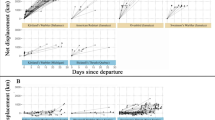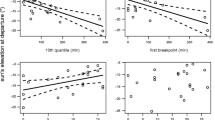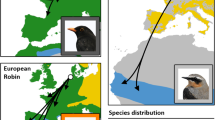Abstract
Stopover studies have concentrated so far mostly on mechanisms regulating the temporal organisation on the day-to-day level. Taking advantage of the small and isolated island of Helgoland in the North Sea, we investigated the stopover and departure behaviour of a nocturnal migrant by using radio telemetry. Special attention was paid particularly to nocturnal behaviour, their departure times within the night, and departure directions. Here, we show that Northern Wheatears, Oenanthe oenanthe, performed regularly nocturnal exploratory flights on nights before and on departure night, which might be a common behaviour of nocturnal migrants to evaluate meteorological conditions aloft prior to departure. We proposed that migrants being prepared for an endurance flight would depart early in the night within a short time window, whereas individuals departing with low fuel load would be less prone to take off early. Our data, however, could not support this hypothesis. In respect of the migratory direction, there was a significant correlation between departure direction and departure fuel load. Northern Wheatears with high departure fuel loads headed more towards the north than lean migrants, which departed mostly towards the nearest coastline, i.e. east to south. Thus, birds with high fuel loads showed their seasonally appropriate migratory direction irrespective of the ecological barrier ahead, whereas lean birds avoided this direction. To our knowledge, this is the first study that investigates the relationship of fuel load and departure direction in a free-flying songbird.
Zusammenfassung
In Studien zum Rastverhalten von Zugvögeln wurden bis jetzt hauptsächlich die Mechanismen untersucht, die die zeitliche Organisation des Rastverhaltens auf der Ebene von Tagen steuern. Wir haben das Rast- und Abzugsverhalten eines Nachtziehers mit Hilfe von Radiotelemetrie untersucht und uns dabei die isolierte Lage der kleinen Nordseeinsel Helgoland zu Nutze gemacht. Besondere Aufmerksamkeit galt dem nächtlichen Verhalten, der Abzugszeit in der Nacht, und der Abzugsrichtung. Hier zeigen wir, dass Steinschmätzer Oenanthe oenanthe regelmäßig nächtliche Erkundungsflüge in Nächten vor und während der Abzugsnacht durchführten, was ein typisches Verhalten von Nachtziehern sein könnte, um die Windbedingungen in verschiedenen Höhen zu testen. Wir nahmen an, dass Zugvögel, die ausreichende Reserven für einen Langstreckenflug hatten, früh in der Nacht während eines relativ engen Zeitfensters abziehen würden, wohingegen Individuen mit geringeren Energiereserven wahrscheinlich früh aber auch spät in der Nacht abziehen. Unsere Ergebnisse konnten diese Hypothese allerdings nicht bestätigen. Zwischen der Abzugsrichtung und den Energievorräten beim Abzug bestand ein signifikanter Zusammenhang. Steinschmätzer mit hohen Energiereserven flogen in nördlichere Richtungen als magere Vögel, die zum größten Teil in Richtung der nächstgelegenen Küste, d.h. nach Osten bis Süden, abzogen. Also zeigten Vögel mit großen Energiereserven ihre jahreszeitlich angemessene Abzugsrichtung unabhängig von der vor ihnen liegenden ökologischen Barriere, während magere Vögel diese Richtung vermieden. Unseres Wissens ist dies die erste Studie, die den Zusammenhang zwischen Energievorräten und Abzugsrichtung an Singvögeln im Freiland untersucht.







Similar content being viewed by others
References
Åkesson S, Hedenström A (2000) Wind selectivity of migratory flight departures in birds. Behav Ecol Sociobiol 47:140–144
Åkesson S, Alerstam T, Hedenström A (1996a) Flight initiation of nocturnal passerine migrants in relation to celestial orientation conditions at twilight. J Avian Biol 27:95–102
Åkesson S, Karlsson L, Walinder G, Alerstam T (1996b) Bimodal orientation and the occurrence of temporary reverse bird migration during autumn in south Scandinavia. Behav Ecol Sociobiol 38:293–302
Åkesson S, Walinder G, Karlsson L, Ehnbom S (2001) Reed warbler orientation: initiation of nocturnal migratory flights in relation to visibility of celestial cues at dusk. Anim Behav 61:181–189
Åkesson S, Walinder G, Karlsson L, Ehnbom S (2002) Nocturnal migratory flight initiation in reed warblers Acrocephalus scirpaceus: effect of wind on orientation and timing of migration. J Avian Biol 33:349–357
Alerstam T (1978) Reoriented bird migration in coastal areas: dispersal to suitable testing grounds? Oikos 30:247–256
Alerstam T (2001) Detours in bird migration. J Theor Biol 209:319–331
Alerstam T, Lindström Å (1990) Optimal bird migration: the relative importance of time, energy, and safety. In: Gwinner E (ed) Bird migration: physiology and ecophysiology. Springer, Berlin, pp 331–351
Bairlein F (1994) Manual of field methods. European-African Songbird Migration Network, Wilhelmshaven
Batschelet E (1981) Circular statistics in biology. Academic, London
Bolshakov CV, Chernetsov N (2004) Initiation of nocturnal flight in two species of long-distance migrants (Ficedula hypoleuca and Acrocephalus schoenobaenus) in spring: a telemetry study. Avian Ecol Behav 12:63–76
Bolshakov CV, Bulyuk V, Chernetsov N (2003) Spring nocturnal migration of Reed Warblers Acrocephalus scirpaceus: departure, landing and body condition. Ibis 145:106–112
Bolshakov CV, Chernetsov N, Mukhin A, Bulyuk V, Kosarev VV, Ktitorov P, Leoke D, Tsvey A (2007) Time of nocturnal departures in European robins, Erithacus rubecula, in relation to celestial cues, season, stopover duration and fat score. Anim Behav 74:855–865
Bruderer B, Boldt A (2001) Flight characteristics of birds: I. Radar measurements of speeds. Ibis 143:178–204
Bruderer B, Liechti F (1995) Variation in density and height distribution of nocturnal migration in the south of Israel. Isr J Zool 41:477–487
Bruderer B, Liechti F (1999) Bird migration across the Mediterranean. In: Adam N, Slotow R (eds) Proceedings of the 22nd international ornithological congress. BirdLife South Africa, Durban, pp 1983–1999
Bulyuk VN, Tsvey A (2006) Timing of nocturnal autumn migratory departures in juvenile European Robins (Erithacus rubecula) and endogenous and external factors. J Ornithol 147:298–309
Caccamise DF, Hedin RS (1985) An aerodynamic basis for selecting transmitter loads in birds. Wilson Bull 97:306–318
Cochran WW (1980) Wildlife telemetry. In: Schemnitz S (ed) Wildlife management techniques manual. The Wildlife Society, Washington, DC, pp 507–520
Cochran WW (1987) Orientation and other migratory behaviours of a Swainson’s Thrush followed for 1500 km. Anim Behav 35:927–929
Cochran WW, Montgomery GG, Graber RR (1967) Migratory flights of Hylocichla thrushes in spring: a radiotelemetry study. Living Bird 6:213–225
Cochran WW, Mouritsen H, Wikelski M (2004) Migrating songbirds recalibrate their magnetic compass daily from twilight cues. Science 304:405–408
Cooke SJ, Hinch SG, Wikelski M, Andrews RD, Kuchel LK, Wolcott TG, Butler PJ (2004) Biotelemetry: a mechanistic approach to ecology. Trends Ecol Evol 19:334–343
Coppack T, Becker SF, Becker PJJ (2008) Circadian flight schedules in night-migrating birds caught on migration. Biol Lett 4:619–622
Crawley MJ (2005) Statistical computing. An introduction to data analysis using S-Plus. Wiley, New York
Delingat J, Dierschke V, Schmaljohann H, Mendel B, Bairlein F (2006) Daily stopovers as optimal migration strategy in a long-distance migrating passerine: the Northern Wheatear. Ardea 94:593–605
Delingat J, Bairlein F, Hedenström A (2008) Obligatory barrier crossing and adaptive fuel management in migratory birds: the case of the Atlantic crossing in northern wheatears (Oenanthe oenanthe). Behav Ecol Sociobiol 62:1069–1078
Delingat J, Dierschke V, Schmaljohann H, Bairlein F (2009) Diurnal patterns of body mass change during stopover in a migrating songbird. J Avian Biol 40:625–634
Deutschlander ME, Muheim R (2009) Fuel reserves affect migratory orientation of thrushes and sparrows both before and after crossing an ecological barrier near their breeding grounds. J Avian Biol 40:1–5
Dierschke V, Delingat J (2003) Stopover of Northern Wheatears Oenanthe oenanthe at Helgoland: where do the migratory routes of Scandinavian and Nearctic birds join and split? Ornis Svec 13:53–61
Dierschke V, Mendel B, Schmaljohann H (2005) Differential timing of spring migration in Northern Wheatears Oenanthe oenanthe: hurried males or weak females? Behav Ecol Sociobiol 57:470–480
Erni B, Liechti F, Underhill LG, Bruderer B (2002) Wind and rain govern the intensity of nocturnal bird migration in central Europe—a log-linear regression analysis. Ardea 90:155–166
Fransson T, Weber TP (1997) Migratory fueling in blackcaps (Sylvia atricapilla) under perceived risk of predation. Behav Ecol Sociobiol 41:75–80
Fuchs T, Haney A, Jechura TJ, Moore FR, Bingman V (2006) Daytime naps in night-migrating birds: behavioural adaptation to seasonal sleep deprivation in the Swainson’s thrush, Catharus ustulatus. Anim Behav 72:951–958
Gauthreaux SA, Belser CG (1999) Bird migration in the region of the Gulf of Mexico. In: Adam N, Slotow R (eds) Proceedings of the 22nd international ornithological congress. BirdLife South Africa, Durban, pp 1931–1947
Goyman W, Spina F, Ferri A, Fusani L (2010) Body fat influences departure from stopper sites in migratory birds: evidence from whole-island telemetry. Biol Lett. 6:478–481
Gwinner E (1990) Circannual rhythms in bird migration: control of temporal patterns and interactions with photoperiod. In: Gwinner E (ed) Bird migration: physiology and ecophysiology. Springer, Berlin, pp 257–268
Gwinner E, Wiltschko W (1978) Endogenously controlled changes in migratory direction of the garden warbler, Sylvia borin. J Comp Physiol 125:267–273
Hedenström A (2008) Adaptations to migration in birds: behavioural strategies, morphology and scaling effects. Philos Trans R Soc Lond B 363:287–299
Hedenström A, Alerstam T (1997) Optimum fuel loads in migratory birds: distinguishing between time and energy minimization. J Theor Biol 189:227–234
Hegedüs R, Åkesson S, Horváth G (2007) Polarization patterns of thick clouds: overcast skies have distribution of the angle of polarization similar to that of clear skies. J Opt Soc Am A 24:2347–2356
Helbig AJ, Berthold P, Wiltschko W (1989) Migratory orientation of blackcaps (Sylvia atricapilla): population-specific shifts of direction during the autumn migration. Ethology 82:307–315
Houston AI (1998) Models of optimal avian migration: state, time and predation. J Avian Biol 29:395–404
Irvine RJ, Leckie F, Redpath SM (2007) Cost of carrying radio transmitters: a test with racing pigeons Columba livia. Wildlife Biol 13:238–243
Jammalamadaka SR, SenGupta A (2001) Topics in circular statistics. World Scientific, Singapore
Jenni L, Schaub M (2003) Behavioural and physiological reactions to environmental variation in bird migration: a review. In: Berthold P, Gwinner E, Sonnenschein E (eds) Avian migration. Springer, Berlin, pp 155–171
Kaiser A (1993) A new multi-category classification of subcutaneous fat deposits of songbirds. J Field Ornithol 64:246–255
Koch JC (1934) Vogelzug unter Einfluss von Leitlinie und Windrichtung. Vogelzug 5:45–52
Komenda-Zehnder S, Liechti F, Bruderer B (2002) Is reverse migration a common feature of nocturnal bird migration?—an analysis of radar data from Israel. Ardea 90:325–334
Ktitorov P, Bairlein F, Dubinin M (2008) The importance of landscape context for songbirds on migration: body mass gain is related to habitat cover. Landscape Ecol 23:169–179
Lank DB, Ydenberg RC (2003) Death and danger at migratory stopovers: problems with “predation risk”. J Avian Biol 34:225–228
Liechti F (2006) Birds: blowin’ by the wind? J Ornithol 147:202–211
Liechti F, Bruderer B (1995) Directions, speed, and composition of nocturnal bird migration in the south of Israel. Isr J Zool 41:510–515
Liechti F, Bruderer B (1998) The relevance of wind for optimal migration theory. J Avian Biol 29:561–568
Liechti F, Steuri T, López-Jurado C, Ribas PLD, Reis MA, Bruderer B (1997) Nocturnal spring migration on Mallorca—schedules of departure and passage. Ardeola 44:207–213
Lindström Å (1990) The role of predation risk in stopover habitat selection in migrating bramblings, Fringilla montifringilla. Behav Ecol 1:102–106
Lindström Å, Alerstam T (1986) The adaptive significance of reoriented migration of chaffinch Fringilla coelebs and bramblings F. montifringilla during autumn in southern Sweden. Behav Ecol Sociobiol 19:417–424
Moore FR (1987) Sunset and the orientation behaviour of migrating birds. Biol Rev 62:65–86
Moore FR (1994) Resumption of feeding under risk of predation. Anim Behav 48:975–977
Moore FR, Aborn DA (1996) Time of departure by Summer Tanagers (Piranga rubra) from a stopover site following spring trans-gulf migration. Auk 113:949–952
Moore FR, Yong W (1991) Evidence of food-based competition among passerine migrants during stopover. Behav Ecol Sociobiol 28:85–90
Morton ML (1967) Diurnal feeding patterns in white-crowned sparrows Zonotrichia leucophrys gambelii. Condor 69:491–512
Mouritsen H, Feenders G, Liedvogel M, Kropp W (2004) Migratory birds use head scans to detect the direction of the earth’s magnetic field. Curr Biol 14:1946–1949
Muheim R, Moore FR, Phillips JB (2006a) Calibration of magnetic and celestial compass cues in migratory birds—a review of cue-conflict experiments. J Exp Biol 209:2–17
Muheim R, Phillips JB, Åkesson S (2006b) Polarized light cues underlie compass calibration in migratory songbirds. Science 313:837–839
Muheim R, Åkesson S, Moore FR (2007) Magnetic compass of migratory Savannah sparrows is calibrated by skylight polarization at sunrise and sunset. J Ornithol 148(Suppl 2):485–494
Mukhin A, Kosarev V, Ktitorov P (2005) Nocturnal life of young songbirds well before migration. Proc R Soc Lond B 272:1535–1539
Naef-Daenzer B (1993) A new transmitter for small animals and enhanced methods of home-range analysis. J Wildl Manage 57:680–689
Naef-Daenzer B (2007) An allometric function to fit leg-loop harnesses to terrestrial birds. J Avian Biol 38:404–407
Naef-Daenzer B, Widmer F, Nuber M (2001) A test for effects of radio-tagging on survival and movements of small birds. Avian Sci 1:15–23
Naef-Daenzer B, Früh D, Stalder M, Wetli P, Weise E (2005) Miniaturization (0.2 g) and evaluation of attachment techniques of telemetry transmitters. J Exp Biol 208:4063–4068
Odum EP (1963) Lipid levels in birds preparing to cross the Sahara. Ibis 105:109–111
Palmgren P (1949) On the diurnal rhythm of activity and rest in birds. Ibis 91:562–576
R Development Core Team (2009) R: a language and environment for statistical computing. R Foundation for Statistical Computing, Vienna. http://www.R-project.org
Rabøl J (1969) Reversed migration as the cause of westward vagrancy by four Phylloscopus warblers. Br Birds 62:89–92
Ramenofsky M, Agatsuma R, Barga M, Cameron R, Harm J, Landys M, Ramfar T (2003) Migratory behaviour: new insights from captive studies. In: Berthold P, Gwinner E, Sonnenschein E (eds) Avian migration. Springer, Berlin, pp 97–110
Rappole JH, Tipton AR (1990) New harness design for attachment of radio transmitters to small passerines. J Field Ornithol 62:335–337
Rappole JH, Warner DW (1976) Relationships between behaviour, physiology and weather in avian transients at a migration site. Oecologia 26:193–212
Rattenborg NC, Mandt BH, Obermeyer WH, Winsauer PJ, Huber R, Wikelski M, Benca RM (2004) Migratory sleeplessness in the white-crowned sparrow (Zonotrichia leucophrus gambelii). PLoS Biol 7:924–936
Richardson WJ (1982) Northeastward reverse migration of birds over Nova Scotia, Canada, in Autumn. Behav Ecol Sociobiol 10:193–206
Richardson WJ (1990) Timing of bird migration in relation to weather: updated review. In: Gwinner E (ed) Bird migration. Springer, Berlin, pp 78–101
Rozenberg GV (1966) Twilight. A study in atmospheric optics. Plenum, New York
Sandberg R (1994) Interaction of body condition and magnetic orientation in autumn migrating robins, Erithacus rubecula. Anim Behav 47:679–686
Sandberg R (2003) Stored fat and the migratory orientation of birds. In: Berthold P, Gwinner E, Sonnenschein E (eds) Avian migration. Springer, Berlin, pp 515–525
Sandberg R, Moore FR (1996) Migratory orientation of red-eyed vireos, Vireo olivaceus, in relation to energetic condition and ecological context. Behav Ecol Sociobiol 39:1–10
Sandberg R, Moore FR, Bäckman J, Löhmus M (2002) Orientation of nocturnally migrating Swainson’s thrush at dawn and dusk: importance of energetic condition and geomagnetic cues. Auk 119:201–209
Schaub M, Liechti F, Jenni L (2004) Departure of migrating European robins, Erithacus rubecula, from a stopover site in relation to wind and rain. Anim Behav 67:229–237
Schaub M, Jenni L, Bairlein F (2008) Fuel stores, fuel accumulation, and the decision to depart from a migration stopover site. Behav Ecol 19:657–666
Schmaljohann H, Dierschke V (2005) Optimal bird migration and predation risk: a field experiment with northern wheatears Oenanthe oenanthe. J Anim Ecol 74:131–138
Schmaljohann H, Liechti F, Bruderer B (2007) Songbird migration across the Sahara—the non-stop hypothesis rejected!. Proc R Soc Lond B 274:735–739
Schwilch R, Piersma T, Holmgren NMA, Jenni L (2002) Do migratory birds need a nap after a long non-stop flight? Ardea 90:149–154
Sillett TS, Holmes RT (2002) Variation in survivorship of a migratory songbird throughout its annual cycle. J Anim Ecol 71:296–308
Svensson L (1992) Identification guide to European passerines. Mirstatryck, Stockholm
Tsvey A, Bulyuk VN, Kosarev V (2007) Influence of body condition and weather on departures of first-year European robins, Erithacus rubecula, form an autumn migratory stopover site. Behav Ecol Sociobiol 61:1665–1674
von Haartman L (1945) Umschlagende Zugrichtung beim Buchfinken, Fingilla c. coelebs L., im Herbst. Ornis Fenn 22:10–16
von Haartman L, Bergman G, Koskimies J (1946) Beobachtungen über umschlagende Zugrichtung der Bachstelze, Motacilla alba L., im Herbst. Ornis Fenn 23:50–62
Wikelski M, Tarlow EM, Raim A, Diehl RH, Larkin RP, Visser GH (2003) Costs of migration in free-flying songbirds. Nature 423:704
Zehnder S, Åkesson S, Liechti F, Bruderer B (2002) Observation of free-flying nocturnal migrants at Falsterbo: occurrence of reverse flight directions in autumn. Avian Sci 2:103–113
Acknowledgments
We are extremely grateful to Franz Bairlein who helped and supported this project in various ways. Volker Dierschke kindly provided some additional data about the release experiments on Helgoland. Continuous field work was only possible because of important support from Ommo Hüppop, Freimut Schramm, Felix Jachmann, and several volunteers of the Institute of Avian Research “Vogelwarte Helgoland”. Meteorological data were kindly supplied by Deutscher Wetterdienst and the NOAA-CIRES Climate Diagnostics Center, Boulder, CO, USA, from their Web site at http://www.cdc.noaa.gov/. Northern Wheatears were caught, ringed, and radio-tagged under a licence from the Ministry for Agriculture, the Environment and Rural Areas, Schleswig–Holstein, Germany. We also wish to thank Ulric Lund very much for his advice about circular statistics. We are very grateful for valuable comments on this manuscript to Franz Bairlein, Lukas Jenni, and two anonymous referees.
Author information
Authors and Affiliations
Corresponding author
Additional information
Communicated by H. Mouritsen.
Rights and permissions
About this article
Cite this article
Schmaljohann, H., Becker, P.J.J., Karaardic, H. et al. Nocturnal exploratory flights, departure time, and direction in a migratory songbird. J Ornithol 152, 439–452 (2011). https://doi.org/10.1007/s10336-010-0604-y
Received:
Revised:
Accepted:
Published:
Issue Date:
DOI: https://doi.org/10.1007/s10336-010-0604-y




